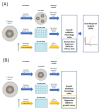Methods for Fungicide Efficacy Screenings: Multiwell Testing Procedures for the Oomycetes Phytophthora infestans and Pythium ultimum
- PMID: 36838315
- PMCID: PMC9959339
- DOI: 10.3390/microorganisms11020350
Methods for Fungicide Efficacy Screenings: Multiwell Testing Procedures for the Oomycetes Phytophthora infestans and Pythium ultimum
Abstract
Oomycetes-borne diseases represent a serious problem for agriculture sustainability due to the high use of chemical products employed for their control. In recent years, increasing concerns on side effects associated with fungicide utilization have led to the reduction of the permissible modes of action, with the remaining ones continuously threatened by the increase of resistant strains in the pathogen populations. In this context, it is mandatory to develop new generation fungicides characterized by high specificity towards the target species and low environmental impact to guarantee the sustainability, productivity, and quality of food production. Fungicide discovery is a lengthy and costly process, and despite these urgent needs, poor description and formalization of high-throughput methodologies for screening the efficacy of active compounds are commonly reported for these kinds of organisms. In this study, a comprehensive picture of two high-throughput practices for efficient fungicide screening against plant-pathogenic oomycetes has been provided. Different protocols using multiwell plates were validated on approved crop protection products using Phytophthora infestans and Pythium ultimum as the model species. In addition, detailed statistical inputs useful for the analysis of data related to the efficacy of screenings are included.
Keywords: fungicide efficacy; oomycetes; plant pathogens; statistical analyses.
Conflict of interest statement
The authors declare no conflict of interest. The funders had no role in the design of the study; in the collection, analyses, or interpretation of the data; in the writing of the manuscript; or in the decision to publish the results.
Figures



Similar articles
-
Biotechnological approaches in management of oomycetes diseases.3 Biotech. 2021 Jun;11(6):274. doi: 10.1007/s13205-021-02810-y. Epub 2021 May 18. 3 Biotech. 2021. PMID: 34040923 Free PMC article. Review.
-
Comparative genomics reveals insight into virulence strategies of plant pathogenic oomycetes.PLoS One. 2013 Oct 4;8(10):e75072. doi: 10.1371/journal.pone.0075072. eCollection 2013. PLoS One. 2013. PMID: 24124466 Free PMC article.
-
Activity of the Novel Fungicide SYP-34773 against Plant Pathogens and Its Mode of Action on Phytophthora infestans.J Agric Food Chem. 2021 Oct 13;69(40):11794-11803. doi: 10.1021/acs.jafc.1c02679. Epub 2021 Oct 4. J Agric Food Chem. 2021. PMID: 34605240
-
Lifestyle, gene gain and loss, and transcriptional remodeling cause divergence in the transcriptomes of Phytophthora infestans and Pythium ultimum during potato tuber colonization.BMC Genomics. 2017 Oct 10;18(1):764. doi: 10.1186/s12864-017-4151-2. BMC Genomics. 2017. PMID: 29017458 Free PMC article.
-
Game-changing alternatives to conventional fungicides: small RNAs and short peptides.Trends Biotechnol. 2022 Mar;40(3):320-337. doi: 10.1016/j.tibtech.2021.07.003. Epub 2021 Sep 3. Trends Biotechnol. 2022. PMID: 34489105 Review.
References
-
- Benavent-Celma C., López-García N., Ruba T., Ściślak M.E., Street-Jones D., van West P., Woodward S., Witzell J. Current practices and emerging possibilities for reducing the spread of oomycete pathogens in terrestrial and aquatic production systems in the European Union. Fungal Biol. Rev. 2021;40:19–36. doi: 10.1016/j.fbr.2021.10.001. - DOI
-
- Derevnina L., Petre B., Kellner R., Dagdas Y.F., Sarowar M.N., Giannakopoulou A., De la Concepcion J.C., Chaparro-Garcia A., Pennington H.G., Van West P., et al. Emerging oomycete threats to plants and animals. Philos. Trans. R. Soc. B Biol. Sci. 2016;371:20150459. doi: 10.1098/rstb.2015.0459. - DOI - PMC - PubMed

